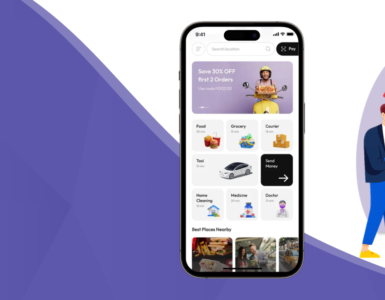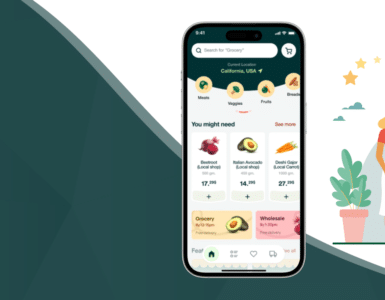The recent COVID-19 pandemic left an unforgettable mark on the world. It didn’t just claim millions of lives—it also severely disrupted the global economy and business ecosystems. Countries worldwide imposed lockdowns to slow the spread of the virus, which in turn triggered a major financial downturn. Many businesses, especially small and medium-sized enterprises, were unprepared for such an event and had no strategy to survive the sudden halt. In particular, traditional offline businesses bore the brunt of the impact, unlike online platforms that were better equipped to sustain operations. A major contributing factor? Many offline businesses lacked a mobile app
Small businesses often considered mobile apps a luxury, not a necessity. But the global lockdown has served as a wake-up call, demonstrating that having a custom mobile application could have made a significant difference. It offered a way to continue operations digitally and cater to customers remotely, ensuring some form of business continuity in uncertain times.
Pandemic-driven evolution of consumer behavior
During the pandemic, governments implemented strict restrictions, confining people to their homes and transforming daily routines. Regular working hours turned into times for managing home tasks and online shopping. Though customers focused on essential items, they increasingly turned to digital platforms for purchasing needs. Fear of crowded areas, combined with the need to avoid physical contact, pushed even traditional shoppers into the online world. This shift has made it vital for grocery store owners and other essential product sellers to consider eCommerce apps to stay in the game.
Local stores operating for limited hours during lockdown created further hurdles for customers. People were forced to change their buying habits. If you sell necessities—like medicines, household products, or food—it’s high time to consider digital transformation. With a 24/7 online store, customers can shop whenever they need. Businesses can continue serving their community despite physical restrictions by adopting a reliable eCommerce platform
To make this transformation, collaborate with an experienced app development company. A strong mobile app strategy allows you to launch an efficient digital store and build a sustainable online presence that can outlast the pandemic’s aftereffects.
Boost your customer service with mobile apps
If you’ve set up a traditional contact center for customer support, lockdowns probably brought your operations to a standstill. However, your customer service cannot afford to stop. Even if your business has temporarily paused, retaining loyal customers is vital. A mobile app can be an excellent medium to offer virtual support, ensuring uninterrupted communication between you and your clients—while also keeping your team safe.
Transitioning from an offline to online system might be tough for support teams used to direct communication. They may become more reliant on digital tools for customer queries. To ease this transition, encourage use of internal communication apps and platforms to maintain collaboration among team members and ensure efficient service delivery.
COVID-19 changed the way we live and work. Innovative entrepreneurs have already started planning for both current survival and future success in a changed world. Safety measures and health guidelines have emphasized the need for automation and self-service options, which mobile apps can efficiently offer. A well-developed app enhances operational transparency and builds customer confidence in your brand.
Extended shutdown? Stay connected and relevant through your app
Depending on your business category, pandemic restrictions might have suspended your services. That doesn’t mean you should lose all engagement with your customers. The situation will eventually improve, and your business must be prepared to resume stronger than before.
Use this time as an opportunity to strengthen your digital presence. Consumers have become increasingly tech-savvy and spend more time browsing mobile apps and websites. An educational, engaging app can help you stay on your customers’ radar even during downtime. This is your chance to introduce them to new services, ideas, and updates that relate to your brand.
Some might argue that social media can achieve the same outcome. However, competition is intense on social platforms. With multiple businesses vying for attention, your posts can easily get lost in the crowd. A dedicated mobile app ensures direct communication with your target audience, giving you more control over their user experience.
What can your app offer? Host webinars, share insightful content, or present future plans like product launches or helpful services. While now may not be ideal for acquiring new clients, retaining existing customers must remain your focus. Your loyal customers are your brand’s backbone—ignore them now, and rebuilding later will be challenging.
When your business reopens, reconnecting with disengaged customers could feel like starting over. That’s why it’s essential to maintain interaction through mobile channels. Use the app as your tool to keep customers engaged and ready for when you bounce back.

Encourage digital payments to reduce health risks
COVID-19 emphasized how easily viruses can spread through physical contact. Many businesses still offered cash-on-delivery options during the pandemic, but cash handling turned out to be a risk factor. Moving towards contactless payments became a safer and more efficient alternative.
Research shows that currency notes, cards, and coins can carry infectious particles for hours, sometimes even days. Encourage customers to use digital transaction options like UPI, IMPS, RTGS, net banking, and mobile wallets. A business app with integrated and secure payment gateways reduces risk while offering a seamless experience for users.
Promoting contactless payments not only aligns with hygiene protocols but also streamlines operations. You reduce the need for handling physical cash and provide faster service—benefiting both customers and employees.
Build apps for seamless internal communication
The sudden surge in remote working has changed how businesses operate. With teams spread out, communication is often the biggest hurdle. How can your employees collaborate effectively while working from home? A customized mobile app can bridge the gap.
A well-designed app allows real-time communication, task tracking, file sharing, and virtual meetings. This ensures that your operations stay functional even if your physical office remains closed. Ensure your app has a responsive layout compatible with various devices, enabling smooth usage across your entire workforce.
If you already use an internal communication app, now might be the perfect time to upgrade it. Add features such as video conferencing, secure document storage, and team-specific chat rooms to enhance productivity and collaboration.
The COVID-19 pandemic has shown just how unpredictable the business landscape can be. Some companies may view 2020 and its aftermath as a setback. But forward-thinking businesses see this as an opportunity for growth. Digital transformation, particularly mobile app adoption, can be a long-term solution to maintain stability, enhance efficiency, and prepare for future challenges.
In conclusion, businesses that embrace technology and act now will be the ones that not only survive but thrive in the post-pandemic world. Mobile apps have become essential tools for customer engagement, remote work, secure transactions, and service continuity—ensuring your brand stays connected, resilient, and relevant.
























